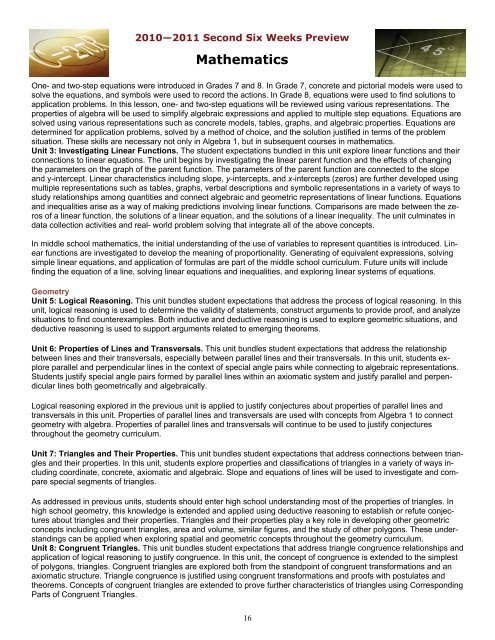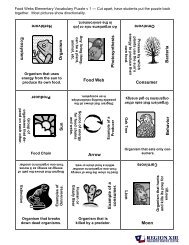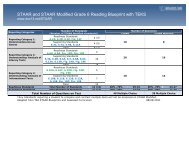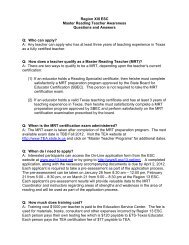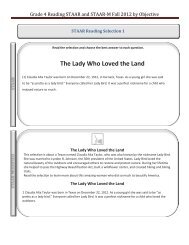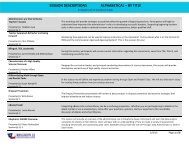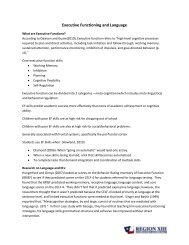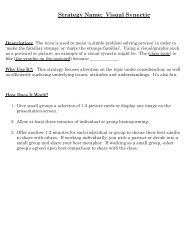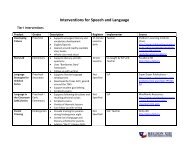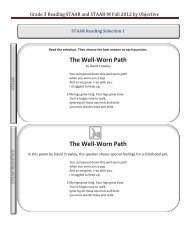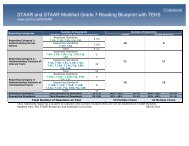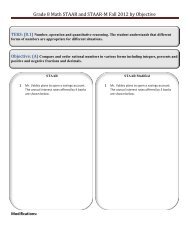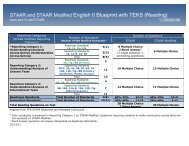2nd Six Weeks Newsletter - Region 13
2nd Six Weeks Newsletter - Region 13
2nd Six Weeks Newsletter - Region 13
You also want an ePaper? Increase the reach of your titles
YUMPU automatically turns print PDFs into web optimized ePapers that Google loves.
2010—2011 Second <strong>Six</strong> <strong>Weeks</strong> PreviewMathematicsOne- and two-step equations were introduced in Grades 7 and 8. In Grade 7, concrete and pictorial models were used tosolve the equations, and symbols were used to record the actions. In Grade 8, equations were used to find solutions toapplication problems. In this lesson, one- and two-step equations will be reviewed using various representations. Theproperties of algebra will be used to simplify algebraic expressions and applied to multiple step equations. Equations aresolved using various representations such as concrete models, tables, graphs, and algebraic properties. Equations aredetermined for application problems, solved by a method of choice, and the solution justified in terms of the problemsituation. These skills are necessary not only in Algebra 1, but in subsequent courses in mathematics.Unit 3: Investigating Linear Functions. The student expectations bundled in this unit explore linear functions and theirconnections to linear equations. The unit begins by investigating the linear parent function and the effects of changingthe parameters on the graph of the parent function. The parameters of the parent function are connected to the slopeand y-intercept. Linear characteristics including slope, y-intercepts, and x-intercepts (zeros) are further developed usingmultiple representations such as tables, graphs, verbal descriptions and symbolic representations in a variety of ways tostudy relationships among quantities and connect algebraic and geometric representations of linear functions. Equationsand inequalities arise as a way of making predictions involving linear functions. Comparisons are made between the zerosof a linear function, the solutions of a linear equation, and the solutions of a linear inequality. The unit culminates indata collection activities and real- world problem solving that integrate all of the above concepts.In middle school mathematics, the initial understanding of the use of variables to represent quantities is introduced. Linearfunctions are investigated to develop the meaning of proportionality. Generating of equivalent expressions, solvingsimple linear equations, and application of formulas are part of the middle school curriculum. Future units will includefinding the equation of a line, solving linear equations and inequalities, and exploring linear systems of equations.GeometryUnit 5: Logical Reasoning. This unit bundles student expectations that address the process of logical reasoning. In thisunit, logical reasoning is used to determine the validity of statements, construct arguments to provide proof, and analyzesituations to find counterexamples. Both inductive and deductive reasoning is used to explore geometric situations, anddeductive reasoning is used to support arguments related to emerging theorems.Unit 6: Properties of Lines and Transversals. This unit bundles student expectations that address the relationshipbetween lines and their transversals, especially between parallel lines and their transversals. In this unit, students exploreparallel and perpendicular lines in the context of special angle pairs while connecting to algebraic representations.Students justify special angle pairs formed by parallel lines within an axiomatic system and justify parallel and perpendicularlines both geometrically and algebraically.Logical reasoning explored in the previous unit is applied to justify conjectures about properties of parallel lines andtransversals in this unit. Properties of parallel lines and transversals are used with concepts from Algebra 1 to connectgeometry with algebra. Properties of parallel lines and transversals will continue to be used to justify conjecturesthroughout the geometry curriculum.Unit 7: Triangles and Their Properties. This unit bundles student expectations that address connections between trianglesand their properties. In this unit, students explore properties and classifications of triangles in a variety of ways includingcoordinate, concrete, axiomatic and algebraic. Slope and equations of lines will be used to investigate and comparespecial segments of triangles.As addressed in previous units, students should enter high school understanding most of the properties of triangles. Inhigh school geometry, this knowledge is extended and applied using deductive reasoning to establish or refute conjecturesabout triangles and their properties. Triangles and their properties play a key role in developing other geometricconcepts including congruent triangles, area and volume, similar figures, and the study of other polygons. These understandingscan be applied when exploring spatial and geometric concepts throughout the geometry curriculum.Unit 8: Congruent Triangles. This unit bundles student expectations that address triangle congruence relationships andapplication of logical reasoning to justify congruence. In this unit, the concept of congruence is extended to the simplestof polygons, triangles. Congruent triangles are explored both from the standpoint of congruent transformations and anaxiomatic structure. Triangle congruence is justified using congruent transformations and proofs with postulates andtheorems. Concepts of congruent triangles are extended to prove further characteristics of triangles using CorrespondingParts of Congruent Triangles.16


